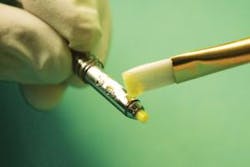Master Bond Inc. has developed a solvent free, two component, toughened epoxy system called Supreme 62-1. It is serviceable from -60°F to +450°F (-51°C to +232°C). Most noteworthy, Supreme 62-1 provides chemical resistance to a wide range of acids, bases, fuels and solvents even at elevated temperatures. It can be used as an adhesive/sealant for aerospace, electronic, optical and specialty OEM applications.
“Master Bond Supreme 62-1 has superior toughness, which makes it suitable for bonding substrates with different coefficients of thermal expansion and allows it to resist repeated thermal cycling”, says Rohit Ramnath, senior product engineer. “This formulation also exhibits a tensile strength of 8,000-9,000 psi and a tensile modulus of 450,000-500,000 psi. Based on its combination of thermal stability and high physical strength profile we can recommend Supreme 62-1 for many applications requiring structural bonding of dissimilar substrates.”
Supreme 62-1 is easy to use and has an advantageous long working life of more than 12 hours after mixing a 100 gram batch. Typical cure schedule options range from 4-6 hours at 140-158°F (60-70°C) to 20-40 minutes at 176-212 °F (80-100°C) to 10-20 minutes at 257°F(125°C). This compound has an elongation of 5-10% and a Shore D hardness of 75-85. Volume resistivity of the cured epoxy exceeds 1014 ohm-cm. Supreme 62-1 is available for purchase in ½ pint, pint, quart, gallon and 5 gallon kits. Specialty packaging in premixed and frozen syringes and in gun kits are available to simplify handling, minimize waste, speed productivity.
